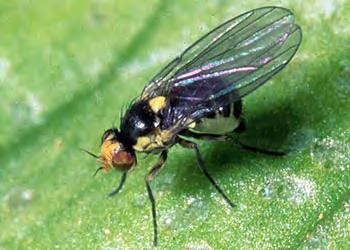
14 minute read
ON THE LAND
Farm safety facts are a solemn reminder
Crop pest discovered
Advertisement
Photo: Merle Shepard, Gerald R. Carner & P.A.C Ooi, Bugwood.org.
CANEGROWERS Chairman Paul Schembri
THE Safer Farms Report 2021 has been sobering reading. My state and my age group have featured strongly, and not in a good way.
FarmSafe Australia puts out an annual report on fatalities and significant injuries on farms.
Overall, there is some positive news with the number of deaths on farms across the country in the first six months of 2021 down on the figure for 2020. At 20 people killed (instead of 30), though, it is still a big problem.
As a Queenslander, what has particularly given me
Paul Schembri
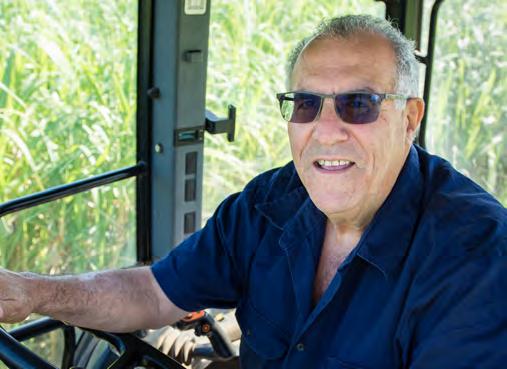
Weekly production figures
Burdekin region mills Week 8, ending 31 July 2021
Cane crushed This week Season to date Invicta 161,010 1,138,875
Pioneer 82,181 609,054
Kalamia
81,446 559,149 Inkerman 54,332 440,813
Burdekin 378,969 2,747,891
CCS
Invicta 15.06 14.09
Pioneer 14.83 14.09
Kalamia
14.46 13.71 Inkerman 14.34 13.45
Burdekin 14.78 13.91
Weekly variety performance for region
Variety % CCS Variety % CCS
Q240 44 15.07 Q232 9 14.25
KQ228 25 14.27 Q208 13.86
Q183 15 15.58
Comments:
This was above budget even though Inkerman Mill did not come back online until Tuesday, following corrective work to the steam-water separators in the boiler drum.
Invicta Mill recorded the best weekly throughput for the year, of just over 160,000 tonnes.
Total throughput for the season to date is now just under 2.75 million tonnes.
Average weekly CCS was 14.78 which is now nearly 0.5 units above budget.
The highest CCS sample was 18.0 from a rake of Q240 plant cane in the Pioneer Mill area.
John Tait Cane Supply Manager Burdekin Region
pause to think is that nearly 60% of the farm-related injuries reported over the past 18 months were in this state.
That is 126 serious accidents in Queensland within the national total of 201.
In those same 18 months, 24 people lost their lives in accidents on Queensland farms. Hitting close to home, 82% of them were men and 62% were aged over 45 years.
Statistics can provide a good opportunity to pause and think.
Farms are complex and busy operations and farmers (including growers) are generally juggling a lot of tasks and responsibilities.
We must be the most multiskilled people in Australia even before you factor in the pressure and stress that goes with running your own business.
With so much going on, there is a lot that could go wrong. Going by the statistics, it goes wrong for the more experienced farmer, those aged over 50, more often than for any other group.
The FarmSafe report made this observation:
“A commonly perpetuated myth on farm is that it is the young adults, with their over confidence and lack of long-term experience, that are most at risk on farm. Yet year in and year out we find that males over the age of 50 are the most likely to be fatally injured. It seems that experience isn’t always the best indication of safe practice.”
I’ll put my hand up and admit that I’ve lost count of the times I’ve thought, “That was close,” after something happened while I was working on the farm. I know most of my colleagues would be the same with their experiences of near misses.
Sadly, virtually every family involved in farming, including the sugar industry, has a story to tell about an accident, and often it resulted in losing someone dear.
One of the things I have observed about Australia after travelling to other countries and visiting sugarcane farms is that we do attach a high value to the safety of farmers
American serpentine leaf miner
ANOTHER invasive crop pest - American serpentine leafminer (ASLM) - has been found in Northern Australia.
The pest is particularly harmful to horticultural crops such as beans, celery, cucumber and lettuce.
ASLM was closely related to the similarly named American leaf miner (ALM), which was first detected in Australia in 2020 and the vegetable leaf miner which has been present in the far north of Queensland for many years.
and to workers in general.
Whilst we might feel that there are too many rules, if we are being honest, we do understand the importance of them and of keeping our workplaces, our farms, and our work practices safe.
The rules, guidelines and campaigns are there for a reason. If nothing else, the FarmSafe report is a reminder of why they are there, to take them seriously and to take stock of what we do and how we’re doing it every day we go to work.
After all, we don’t want our people, our family, to become part of next year’s statistical review.
Glencore champions jobs in regional Queensland
Glencore
GLENCORE is investing in entry-level job opportunities across Queensland, with 266 apprentices and 115 graduates currently building their resource sector careers with Glencore’s Coal and Queensland Metals businesses.
We continue to be one of Queensland’s largest natural resource sector employers and have a range of entry-level programs, including for school leavers or university graduates and people of all ages looking for a new challenge or career opportunity.
“We’re proud that we have been able to continue hiring and providing exciting and well-paid jobs to support Queensland’s economic recovery from the COVID-19 pandemic,” Glencore’s Regional Human Resource Lead Jodie Hope said.
“Glencore employs 8,590 people across the state at our operations generating $8 billion in total economic value,” said Ms Hope.
“This year, 67 first-year apprentices and 51 graduates started their careers across Glencore sites, many of whom come from the regional communities where we operate.
“From Mount Isa and Cloncurry in the northwest, to Clermont and Tieri in Central Queensland, our employment programs provide a challenging mix of on-the-job experience and mentoring by some of the best leaders in the business.
“Recruitment campaigns for our programs occur yearround.
Applications for our 2022 Queensland Metals Apprenticeship Program are currently open and applications have recently closed for our 2022 Coal Apprenticeship program with candidate selection underway.”
The Queensland Metals apprentice program offers opportunities in the electrical, auto electrical, diesel fitting, fitter welder, radio technician, boilermaker, mechanic, fitter turner and refrigeration trades.
In addition to the firstclass training and mentoring opportunities, the four-year program rotates apprentices across Glencore’s diverse operations and is tied to a direct career path within the business.
“Not only do we have a large number of apprentices across many different trades, we have a high completion rate of 96% over the past five years, significantly above the general industry rate of 56% for trades,” Ms Hope said.
“We look for bright, curious and confident people and provide them with the tools and support they need to succeed.
Glencore’s in-house employment programs include opportunities for university graduates, apprenticeships, trainees, vacation and work experience students, as well as school leavers.
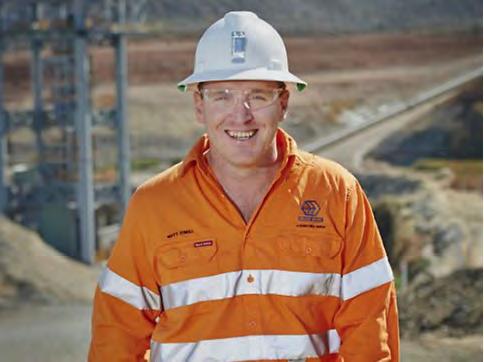
CONNECT NOW:
Applications for Glencore’s Queensland Metals 2022 Apprenticeship Program can be made here (search reference QMAPPRENTICE2022). Applications close Sunday 8 August 2021.


On the Land is proudly supported by


Wilmar moves to reassure worried Inkerman growers
Max Tomlinson
CANE Farmers supplying Inkerman Mill are becoming increasingly concerned about the slowdown in the mill’s current crushing rate.
However, Wilmar has moved quickly to reassure growers that it had put in place a plan to reduce delays.
AgForce Cane President Ricky Mio said ongoing mechanical problems at the mill had slowed this year’s harvest, increasing the season length, resulting in flow-on effects for growers, field workers and the many industries that rely on the sugar economy for their livelihood.
“I know that Wilmar (operators of the Inkerman Mill) staff are working hard to get on top of their mechanical problems but I think it’s important to maintain clear and open dialogue about finding solutions before the situation worsens,” he said.
Mr Mio said his concerns were based on the following: • A crushing target of 77,000 tonnes per week is becoming unachievable if crushing is to finish by November 20; • Ratoon Stunting Disease in the region is on the rise, thus reducing the available tonnage for the 2022 season; • The prospects of late ratooning will result in production losses for next season; and • The possibility of standover cane could result in growers not being able to capitalise on higher prices, or worse, having sugar sold but unable to fill orders.
“It would be frustrating for me if I was a producer supplying Inkerman Mill to be told to stop crushing and then watch trucks hauling cane through Home Hill to north bank mills,” said Mr Mio.
Mr Mio said he believed an increase in the rate of cane transfer rates to between 1000-1600 tonnes a day would reduce Inkerman crush time by three weeks and only add an extra five days to the north bank mills’ season.
“This would also help to restore faith in Wilmar and demonstrate muchneeded leadership,” he said.
Mr Mio questioned why Inkerman had struggled to achieve crushing rates over 90% of capacity in recent years.
“We feel there is an issue at Inkerman that needs to be resolved sooner rather than later,” he said.
Wilmar Sugar’s General Manager Operations Mike McLeod said in a statement that the down time at Inkerman Mill last month was caused by a specific issue with the steam-water separator in the boiler steam drum. The issue was resolved and Inkerman Mill resumed crushing operations last Tuesday morning (27 July).
“We are transferring Inkerman cane to our north bank mills to minimise the impact of recent factory stops on Anchorman Mill’s season finish date,” he said. ”The transfers will not impact north bank growers adversely as both Invicta and Pioneer mills have available crushing capacity.
“We engaged all grower collectives, including AgForce Cane, about the transfer plans and all were supportive,” he said.
Mr McLeod said cane transfers began two weeks ago and were ramped up significantly this week.
“We plan to continue transferring Inkerman cane, seven days a week, for several weeks,” he said.
“Our crushing targets are realistic and we are optimistic about meeting forecast finish dates.Talk of standover cane, this early in the season, is premature. ”As always, we will continue to keep our cane suppliers informed of weekly production targets and throughputs,” he said.
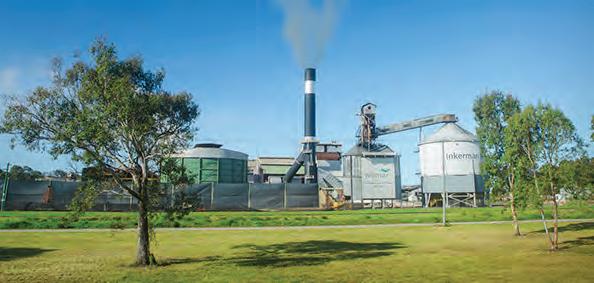
Photo courtesy Wilmar Sugar
SCIENCE AND POLITICS ALREADY JOINED AT THE HIP
AgForce CEO Michael Guerin
Scientists should never seek to hold themselves above scrutiny.
But in his Letter to the Editor in QCL on 22 July, ‘Let’s keep politics out of science’, Dr Ross Hynes of The Royal Society of Queensland seeks to shoot down AgForce and other industry groups calling for the creation of an independent Office of Science Quality Assurance, stating repeatedly that “peerreviewed” publications are, well, peerless.
In his letter, Dr Hynes states that a new office would “undermine the traditional capacity of the public service to provide trustworthy advice…politicising what ought to be objective analysis.”
But from where AgForce, other industry groups, and rural communities and producers stand, science has been in bed with political parties of all colours and stripes for decades.
Agriculture has frequently been on the receiving end of flawed, highly questionable, peer-reviewed science used to devastatingly debilitating effect when legislating on areas including vegetation and the Great Barrier Reef.
Science has in fact, with each passing decade and astonishing advancement, become less trustworthy because of the very ‘spin’ Dr Hynes would like politicians, commentators, and lobbyists to avoid.
Obvious by omission to this list of people accused of bending scientific facts to achieve their own ends are greens groups. In fact, anyone whose opinions might align with the views of The Royal Society itself.
There are countless examples where the rigour of peer-reviewed publications has been questioned in the medical, education, and environmental fields.
In 2019, Australia’s Chief Scientist Dr Alan Finkel identified several issues with the integrity and calibre of Australian research in his article in The Conversation, ‘There is a problem’: Australia’s top scientist Alan Finkel pushes to eradicate bad science’.
In July 2020, the Queensland Crime and Corruption Commission released an audit report into reducing the risk of research fraud, often triggered by the scientific requirement to “publish or perish”.
In calling for a national Office of Science Quality Assurance, AgForce and industry groups are pursuing a reform into ‘trustworthy knowledge’, untarnished by politics, activists, or fundingdependent scientists.
Why any scientist worth his salt would question that level of independent oversight and rigour should perhaps be the subject of its own independent analysis.
QSL Market Update current as of 3 August 2021
Raw Sugar prices
• Raw sugar prices enjoyed almost an entire week of trading above 18 USc/lb as the Centre South (CS) Brazil cane crop continued to deteriorate. The October 2021 ICE 11 contract opened last week at 18.22 USc/lb before moving as high as 18.81 USc/lb and then trending lower on Friday to 17.80
USc/lb. • News of another frost in the sugar cane areas of CS
Brazil spooked the market higher early in the week. However, this was short lived as the third frost of the season was reportedly less severe than its predecessors. That being said, it will take a number of weeks before the full extent of damage and disruption to the harvesting schedule can be accurately assessed. • The Brazilian cane crop update for the first half of July was published by UNICA during the week (see Jargon Buster), revealing a mixed bag of results. Cane harvested and sugar produced for the season to date was 256.7 million tonnes and 15.2 million tonnes respectively, both down approximately 7% year-on-year. Total Recoverable Sugars (ATR)/tonne of sugarcane on the other hand is up 1.43% year-on-year. • Reports from India suggest the Indian Food Minister has unofficially hinted at a 3,500 Rupee subsidy for 6 million tonnes of exports for the upcoming season. This is almost half the value of the subsidy available for the 2020/21 Season. • The latest Commitment of Traders report for the period ending 27 July showed speculators had pushed their net-long position out from 198,000 lots to 226,000 lots.
2021-SEASON RAW SUGAR PRICES
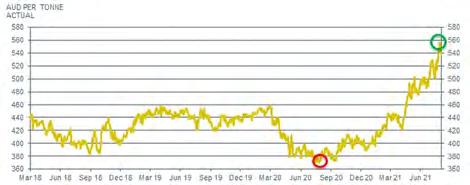
This is a whole-of-season ICE 11 price chart for the 2021 Season, based on the current 3:2:1 pricing ratio applicable to QSL Target Price Contract growers. Source: Bloomberg
Currency
• The Australia Dollar (AUD) has appeared to briefly find support in the 73 US cents range after free-falling from 77 USc only weeks ago. However rising case numbers of the COVID-19 Delta variant and extended lockdowns across
Australia are likely to put downward pressure on the AUD, pushing it towards 70 USc over coming months. The Aussie traded a fairly narrow range last week, reaching its low of 73.17 USc on Wednesday before peaking at 74.13 USc on
Thursday. • The US Dollar shifted slightly lower mid-week after US
Federal Reserve chairman Jerome Powell stated in the post-FOMC (Federal Open Market Committee) meeting that the US had made some progress towards its goals but this was not considered substantial. He also noted that the employment-level target was still a long way off and that the
Fed was nowhere near considering raising rates. • Domestically, the Consumer Price Index for the second quarter printed slightly above market expectations at 0.8% for the quarter and 3.8% for the year, up from 1.1% at the same time last year. The AUD paid little attention to the data as a small changes in inflation are unlikely to push the extremely dovish Reserve Bank into action any time soon given the spiralling COVID-19 situation in Australia.
To read our full commentary in the QSL Market Update, please visit www.qsl.com.au or contact the Burdekin QSL team: Russell Campbell, Grower Relationship Manager 0408 248 385 Kristen Paterson, Grower Relationship Officer 0438 470 235 Rebecca Love, Grower Relationship Officer 0429 054 330
This report contains information of a general or summary nature. While all care is taken in the preparation of this report, the reliability, accuracy or completeness of the information provided in the document is not guaranteed. The update on marketing and pricing activity does not constitute financial, investment advice. You should seek your own financial advice. Nothing contained in this report should be relied upon as a representation as to future matters. Information about past performance is not an indication of future performance. QSL does not accept any responsibility to any person for the decisions and actions taken by that person with respect to any of the information contained in this report.



